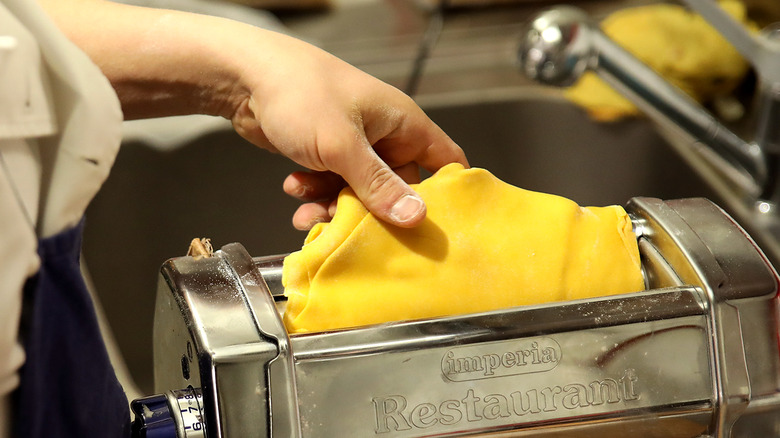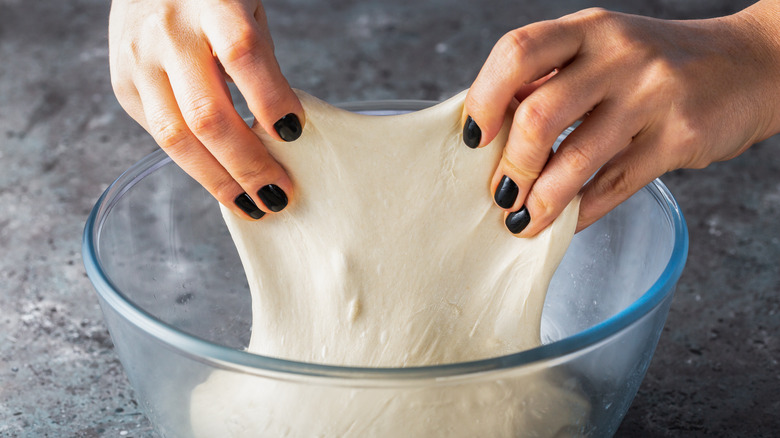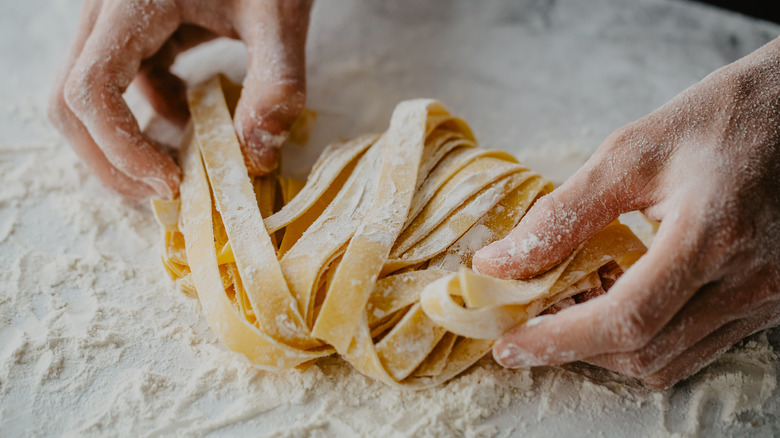The Biggest Mistake People Make When Rolling Pasta Dough
Making pasta dough at home is the type of culinary activity that can be fun to do but difficult to master. Your first batch might turn out perfectly; but, on the second or third try, you might be wondering what secret trick you performed accidentally the first time. One common problem that folks seem to have when they're making homemade pasta dough is watching their dough turn ragged and be filled with holes during the rolling process. Instead of creating thin sheets of beautifully soft pasta, their dough is coming out looking shredded and unworkable.
This problem likely stems from one of the most common mistakes, which is to skip dough lamination. Laminating a dough simply means folding it over itself. While this might seem like an insignificant step, it can help build strength in your dough that will help it to survive the pasta rollers.
After you've rolled your pasta through on the widest setting, simply fold it over itself lengthwise, and press the folds together to get all the bubbles out. Then, run it through the pasta machine again on the widest setting before proceeding ahead with the process.
How laminating pasta dough gives it strength
When talking about laminating in a culinary sense (not coating a piece of paper in plastic), it often refers to the process that creates croissants, pastries, and puff pastry doughs. This means that the dough is layered and folded over itself but with an added layer of fat between, whether that's butter or oil. That fat creates bubbles and expands the layers to create the most dramatic and crisp treats.
Laminating a dough without fat doesn't have the same purpose, however. Laminating pasta or bread dough simply helps the gluten networks to strengthen and develop. It does this by agitating the dough's gluten. If you folded it too much, then the gluten would overdevelop and your dough would be tough and chewy. By giving pasta dough just a single fold it gives it just enough durability to survive being pressed between the rollers.
So, while folding your dough may seem like a small step that's worth skipping, your dough will be stronger for just that one fold.
Other possible causes for tearing pasta dough
Of course, a lack of lamination isn't the only thing that can cause underdeveloped gluten or weak dough.
One reason that your dough still might not be strong enough — even with that fold — is that it wasn't kneaded thoroughly enough. Kneading is the main process that gives your pasta dough a strong network of protein to stretch out nice and thin. If you cut that process short by a few minutes, your dough might not be able to handle the process of rolling out and will tear instead.
Another element to consider is proper dough hydration. Having dough that is too wet or too dry will either make the dough stick to the rollers or crack and tear respectively. This can be difficult to nail down because even a perfectly mixed dough will start out wet and sticky but become smoother and more consistent as it's kneaded.
Make sure that you're measuring all of your ingredients correctly to avoid having an unbalanced dough, and don't be afraid to add a few drops of water or a little bit of flour to help balance things out as you are almost finished kneading.


